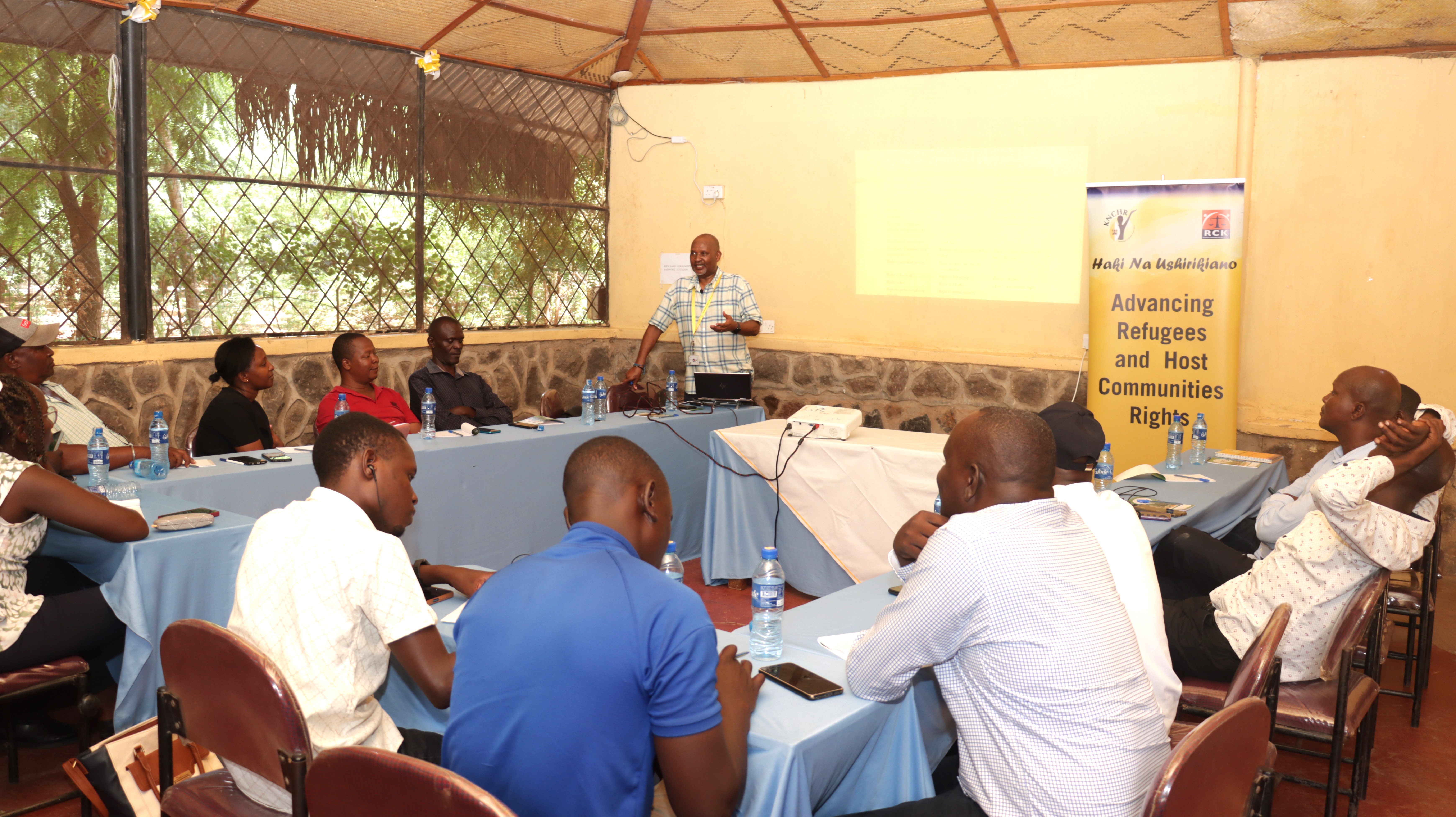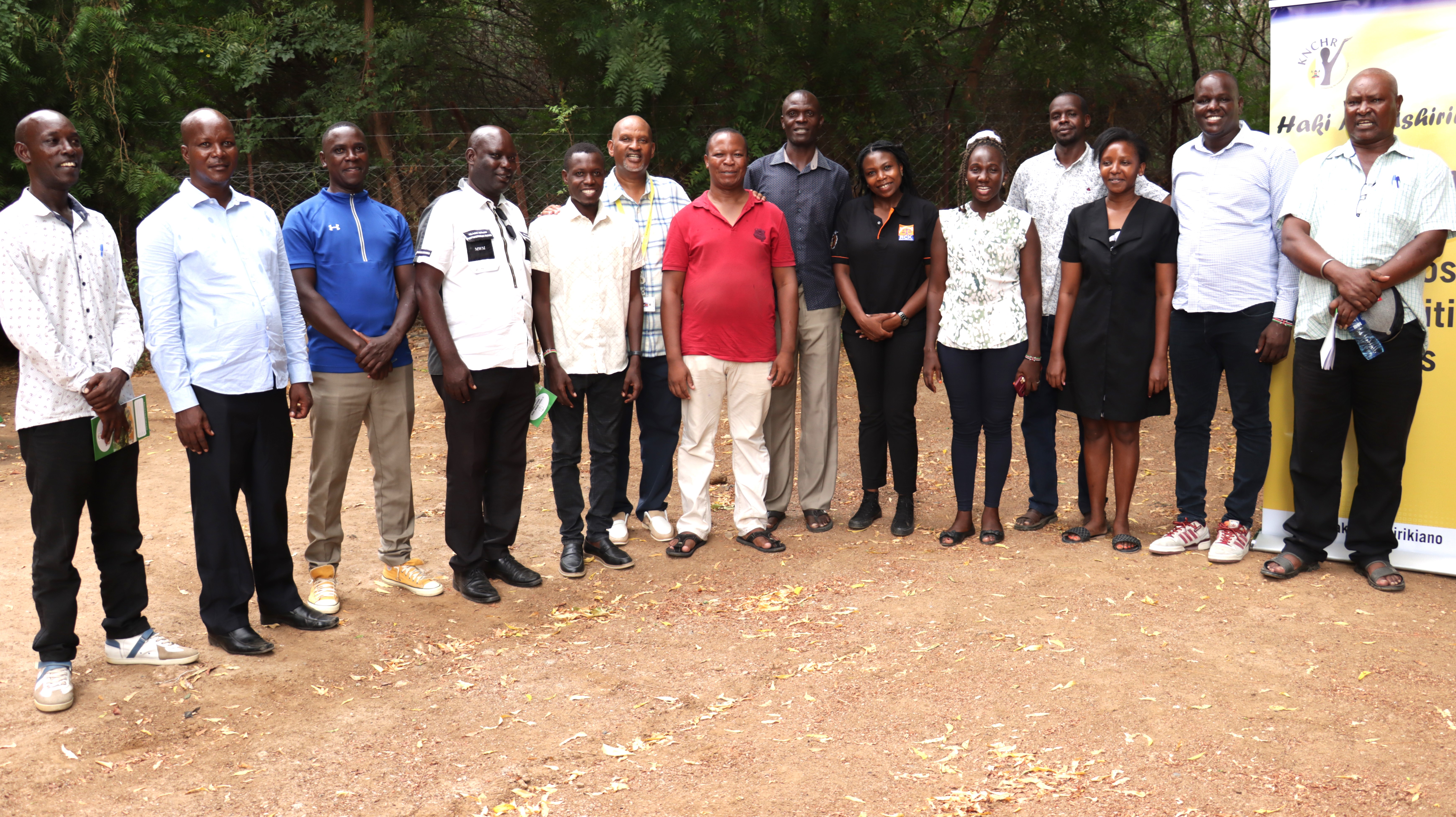Building Bridges: The Role of Journalism in Advancing the Rights and Integration of Refugees and Host Communities

Mr. Dominic Kabiru, Ass. Director Public Affairs and Communication Department - KNCHR, during a session with the media practitioners at a training in Lodwar, Turkana County.
Building Bridges: The Role of Journalism in Advancing the Rights and Integration of Refugees and Host Communities
By Dominic Kabiru and Harriet Ajiambo
Under the banner of "Haki na Ushirikiano-Advancing Refugees and Host Communities Rights”, a project being co-implemented and championed by the Kenya National Commission on Human Rights (KNCHR) and the Refugee Consortium of Kenya (RCK), a transformation is taking shape; in the heart of Turkana County, where the arid landscape meets the resilience of its people. The project, whose name translates to "Justice and Cooperation," is a beacon of hope for refugees and host communities alike, striving to foster peaceful coexistence through advocacy, legal support, and community engagement. At the core of this initiative lies a powerful ally, the media.
Journalists, often dubbed the watchdogs of society and the “voice of the voiceless”, hold the profound responsibility of amplifying the voices of the vulnerable and marginalized. Nowhere is this more evident than in the refugee camps and settlements of Kakuma and Kalobeyei, where thousands seek solace after fleeing conflict, persecution, and economic devastation. The media’s role in telling their stories with dignity, accuracy and responsibility is indispensable.
Recognizing this, the KNCHR Public Affairs & Communication Team, conducted a specialized capacity-building training for journalists in Lodwar on Friday March 28, 2025, at the St. Teresa Catholic Pastoral Centre. The training, attended by journalists from mainstream media and local community radio stations, was more than just a session on reporting techniques. It was a transformative experience, reinforcing the need for a human-rights-based approach in their reporting and coverage of salient issues affecting refugees and the host communities. Participation, Accountability, Non-discrimination, Transparency, Equality and the Rule of Law; these six pillars formed the backbone of the training as the Turkana County based journalists shared their lived experiences while on duty.
Through the interactive sessions between KNCHR and the media team, case studies, and real-life testimonies were shared by the journalists, who left with a renewed sense of purpose: to be the voice for those unheard and to champion stories that foster integration rather than division between the host communities and refugees.
According to journalists in the region, one of the biggest challenges in refugee and host communities coverage and reporting; is the risk of perpetuating stereotypes. Sensationalized narratives that paint refugees as threats rather than survivors of unimaginable hardship contribute to societal divisions. The Haki na Ushirikiano Project thus seeks to change this by empowering journalists with the tools to report objectively and responsibly.
A shining example of impactful journalism emerged from this training initiative. *Miriam* (not her real name), a reporter for a local Turkana radio station, said she had long struggled with how to balance community concerns with the realities of refugee presence. “Through the training, I have now learnt the value of framing my news and feature stories within human rights based approach and principles”, she said.
According to Dominic Kabiru; the Lead trainer from KNCHR. “Kenya National Commission on Human Rights has applied this deliberate strategy of equipping journalists with skills that transcend reporting. He further said; “by embracing a solutions-oriented approach, media practitioners in the region can highlight success stories that inspire rather than instill fear.” The Lodwar training further emphasized constructive journalism; an approach that not only identifies problems but also showcases solutions.
Beyond changing public perception, responsible journalism can influence policy. KNCHR recognizes that policy-makers often rely on media reports to understand ground realities. A well-researched, human rights-based story can thus expose gaps in refugee protection, prompting government action; through the duty bearers on the ground.
The attending journalists, attested that in the past they have individually and collectively carried out a series of investigative news and feature pieces that have uncovered malpractices in the treatment of refugees by certain duty bearers. Equally, the journalists confirmed that they have played a crucial role in highlighting other malpractices. By shining a light on human rights issues, such as gender-based violence (GBV) in refugee camps and settlement, journalists definitely become catalysts for change, turning the media into a formidable force for justice and social transformation culminating in positive integration between the refugees and the host communities.
At the end of the engaging session, the journalists who had gathered for training left with more than just notebooks filled with insights. They carried a renewed commitment to ethical journalism and a deeper understanding of their role in shaping the discourse surrounding refugees, host communities, duty bearers and policy makers; which admittedly at times has become adversarial. The partnership between the media, KNCHR, RCK, and the refugees and host communities is a testament to what can be achieved when justice and cooperation form the foundation of engagement.

KNCHR Public Affairs and Communication officers (6L and 6R) pose for a photo with journalists after a training organized by the Haki na Ushirikiano Project.
Going forward, the Haki na Ushirikiano Project aims to expand its training sessions to other regions, ensuring that more journalists are equipped to tell human-interest stories that bridge divides. The success of this initiative is measured not just in news articles and broadcasts, but in the tangible changes it inspires - better policies, stronger community ties, and a Kenya where refugees and host communities thrive together.
In the end, the media is more than just a mirror reflecting society; it is a beacon that illuminates paths toward justice, dignity, integration and coexistence. And in the arid landscapes of Turkana County that houses the Kakuma Camp and Kalobeyei settlements, amidst the struggles and triumphs of refugees and host communities, the voices of hope continue to rise louder, stronger, and impossible to ignore.
(The Writers are KNCHR Staff in the Public Affairs and Communication Division)